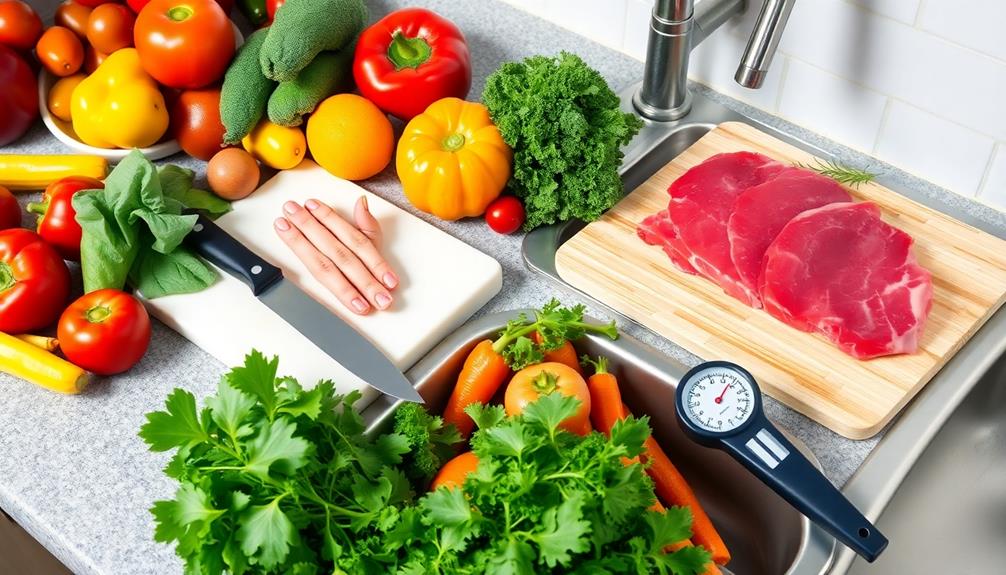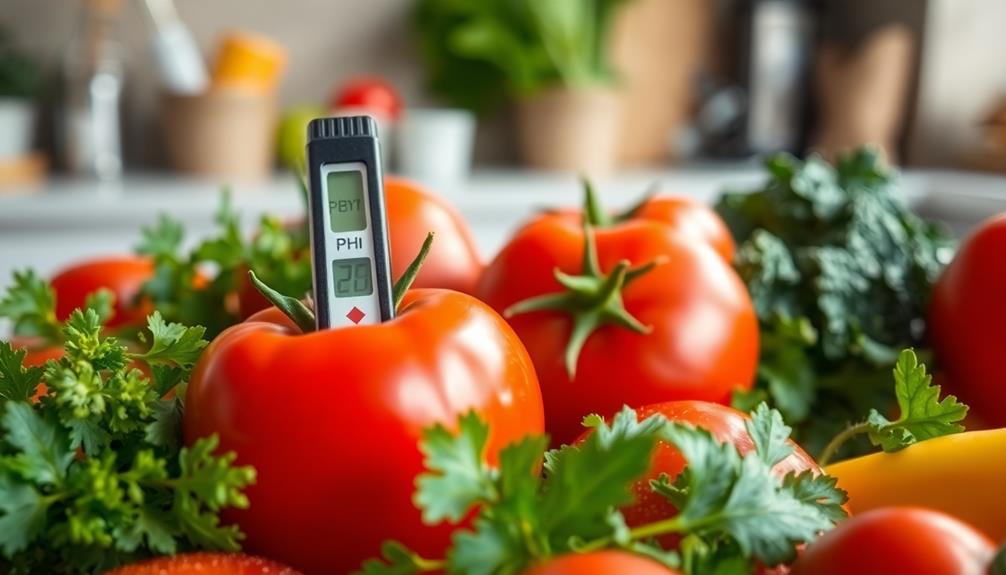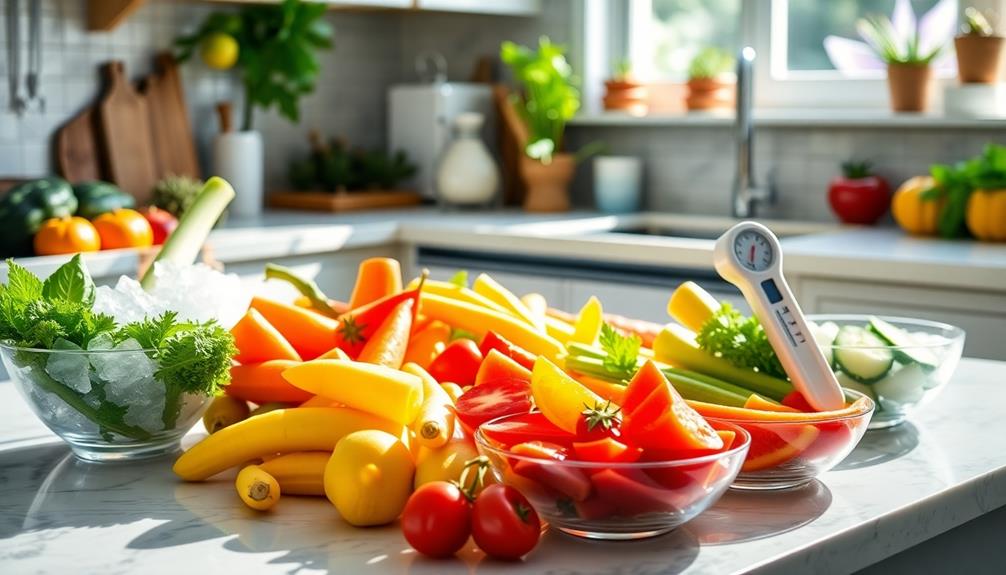Raw food safety training for home cooks is crucial to reduce the risk of foodborne illnesses. Each year, 600 million people get sick due to contaminated food, and improper handling is a leading cause. You'll want to follow key practices like washing your hands often, keeping raw and cooked foods separate, and cooking to safe temperatures. Avoid common mistakes, like washing raw meat, to prevent cross-contamination. Pay attention to proper food storage and serving techniques, too. You're on the right track, and there's even more to explore about keeping your kitchen safe and healthy.
Key Takeaways
- Always wash hands with soap before and after handling food to reduce the risk of foodborne illnesses.
- Keep raw meats separate from other foods to prevent cross-contamination during preparation and storage.
- Cook food to safe internal temperatures to eliminate harmful bacteria and pathogens.
- Store perishables at 40°F or below and avoid leaving food in the danger zone for over two hours.
- Regularly clean surfaces and utensils to maintain a safe kitchen environment.
Importance of Food Safety
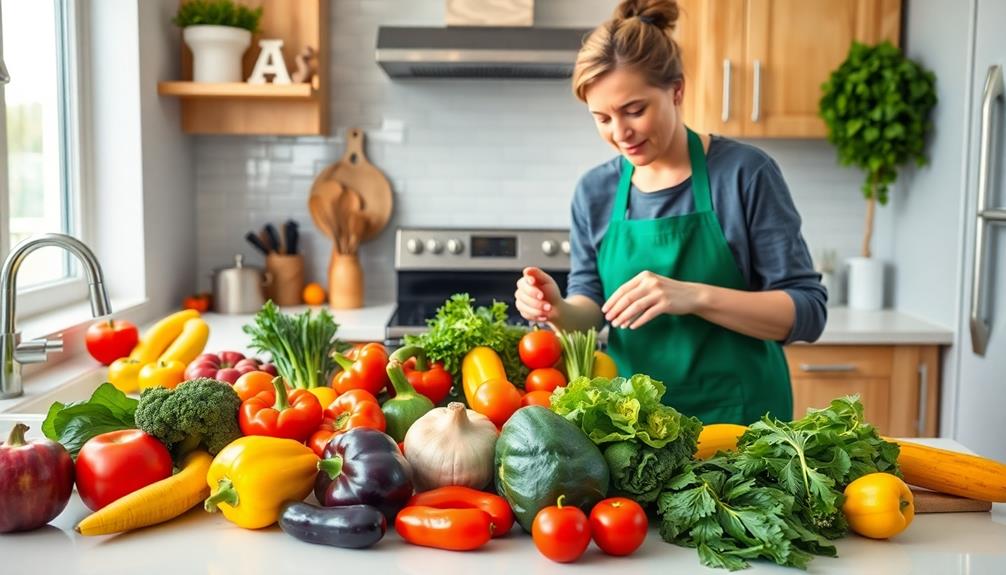
When it comes to food safety, everyone should be aware of its vital importance. Did you know that the World Health Organization estimates 600 million people fall ill each year due to contaminated food? That's a staggering figure, resulting in 420,000 deaths annually.
Improper food handling, particularly in home kitchens, is a leading cause of foodborne illnesses. This highlights the need for you to adopt proper food safety practices.
To minimize the risk of contamination, follow the CDC's four essential steps: Clean, Separate, Cook, and Chill.
Start by washing hands thoroughly with soap before and after handling food. This simple act can greatly reduce your risk of preventing foodborne illness.
Next, verify you're cooking food to a safe temperature; this is vital in killing harmful bacteria that may linger.
Common Food Safety Mistakes
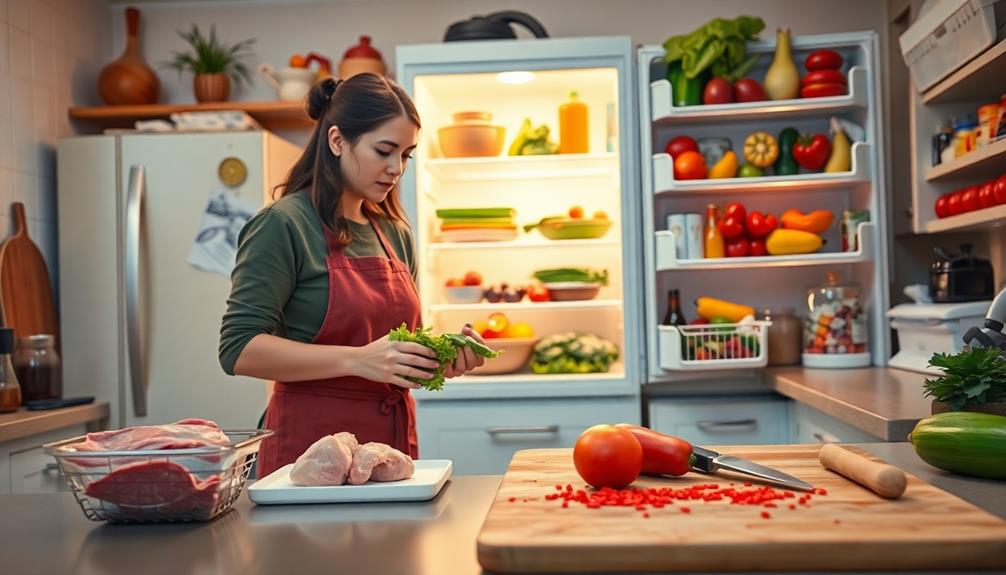
Avoiding common food safety mistakes is vital for keeping you and your loved ones safe from foodborne illnesses. One major mistake is tasting food to check for spoilage. If food's been in the fridge for more than three days, toss it out to prevent illness.
Cross-contamination is another risk you should avoid. Always use separate dishes for raw meat and cooked foods to stop harmful bacteria from spreading.
When it comes to thawing, don't leave food at room temperature; instead, thaw it in the refrigerator or cold water to keep bacteria at bay.
Washing raw meat is also a common misconception. This practice can actually spread bacteria; you should only wash fruits and vegetables.
Additionally, marinating food at room temperature can promote bacterial growth, so always marinate in the refrigerator to guarantee safety.
Lastly, pay attention to food storage. Keeping food properly sealed and at the right temperatures is essential for minimizing risks.
Understanding Germs and Bacteria

To keep your food safe, it's crucial to understand common foodborne pathogens like Salmonella and E. coli.
You need to be aware of safe cooking temperatures and proper food handling techniques to prevent illness.
Common Foodborne Pathogens
Understanding the common foodborne pathogens that can impact your health is vital for safe food handling. These pathogens are often found in raw meat and can lead to serious foodborne illnesses if not handled properly.
Campylobacter, for instance, is frequently linked to undercooked poultry and raw milk, affecting millions each year. E. coli, another important threat, is often associated with unpasteurized milk, undercooked meat, and contaminated produce, potentially causing severe gastrointestinal issues.
Listeria monocytogenes can even thrive in your refrigerator, mainly found in unpasteurized dairy products, posing serious risks, especially to pregnant women and those with weakened immune systems.
Salmonella is commonly found in poultry and eggs, making it essential to cook chicken to at least 165°F to kill any harmful bacteria.
Properly washing fruits and vegetables is equally important, as many foodborne illnesses stem from pathogens like Salmonella and E. coli.
Safe Cooking Temperatures
Safe cooking temperatures are vital in guaranteeing that harmful germs and bacteria are eliminated from your food. When cooking poultry, make sure it reaches an internal temperature of 165°F (73.9°C) to effectively kill pathogens like Salmonella and Campylobacter.
For ground meats, aim for a minimum internal temperature of 160°F (71.1°C) to confirm all harmful bacteria are destroyed throughout the product.
If you're cooking steaks and roasts, cook them to at least 145°F (62.8°C) and let them rest for three minutes before carving or consuming. This rest time is essential for killing any remaining bacteria.
Don't forget about eggs; they need to be cooked until both the yolk and white are firm, hitting that same minimum temperature of 160°F (71.1°C) to reduce the risk of Salmonella infection.
Lastly, when reheating leftovers, make sure they reach an internal temperature of at least 165°F (73.9°C) to eliminate any bacteria that might've developed during storage.
Proper Food Handling Techniques
Proper food handling techniques are essential for preventing foodborne illnesses caused by harmful germs and bacteria. When you're dealing with raw meat, it's imperative to minimize the risk of contamination. Never wash raw meat; this can spread bacteria around your kitchen. Instead, focus on keeping your hands and surfaces clean.
Always wash fruits and vegetables thoroughly to remove any surface pathogens. Understanding the cooking temperature is critical for safety. For instance, chicken should be cooked to an internal temperature of 165°F to eliminate Salmonella. Be aware that certain pathogens, like Campylobacter and E. coli, often lurk in raw meat, so proper food handling techniques are your first line of defense.
Additionally, be cautious with dairy products; Listeria can grow at refrigeration temperatures and is commonly found in unpasteurized dairy. Always source your ingredients safely and verify they're handled properly.
Safe Food Storage Practices

Consistently following safe food storage practices is essential for preventing foodborne illnesses and maintaining the quality of your meals.
To begin with, keep your refrigerator at 40°F or below and your freezer at 0°F or lower. This inhibits bacterial growth, ensuring your food remains safe. When storing raw meat and poultry, always place them in separate containers to avoid cross-contamination with other foods. It's best to consume these items within 1 to 2 days of refrigeration.
Use airtight containers to store leftovers and other foods. This not only helps maintain freshness but also reduces the risk of spoilage and contamination.
Regularly check your storage temperatures and expiration dates to meet food safety standards. You should never leave food at room temperature in the danger zone (40°F to 140°F) for more than two hours; doing so can increase the risk of foodborne illness.
Preventing Cross Contamination
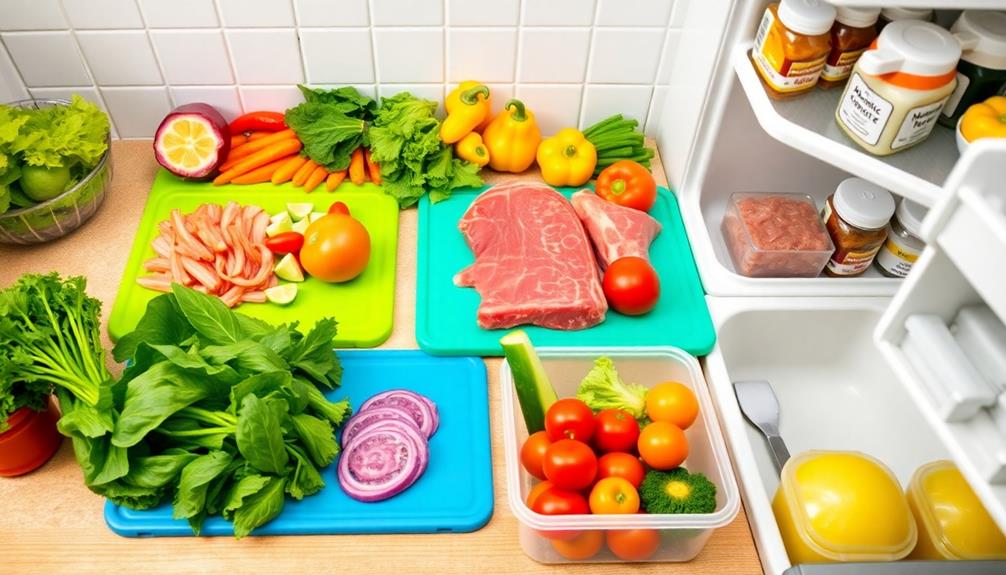
To prevent cross-contamination, you need to use separate utensils and cutting boards for raw meat and fresh produce.
It's essential to store raw meat properly and keep it packaged away from other food items.
Importance of Separate Utensils
When preparing food, using separate utensils for raw meat and vegetables is essential for keeping your kitchen safe. Cross-contamination can lead to serious foodborne illnesses, as harmful bacteria from raw meat can easily transfer to ready-to-eat foods. To minimize this risk, it's important to have separate cutting boards for raw meat and produce.
Here's a quick reference table to help you organize your kitchen utensils:
| Utensil Type | Usage | Cleaning Tips |
|---|---|---|
| Separate Cutting Boards | Raw meat and vegetables | Wash with hot, soapy water |
| Knives | Cutting meat and produce | Sanitize after each use |
| Plates | Serving cooked food | Never reuse for raw meat items |
Additionally, never reuse unwashed plates that held raw meat for salads or cooked foods. During grocery shopping, keep raw meat separate from other foods in your cart. Regularly cleaning surfaces and utensils after handling raw foods is essential to prevent bacteria from lingering. By following these practices, you can markedly reduce the chances of cross-contamination in your kitchen.
Safe Food Storage Practices
One of the simplest ways to prevent cross-contamination in your kitchen is by practicing safe food storage. By following specific guidelines, you can noticeably reduce the risk of foodborne illness caused by raw meat.
Here are some essential safe food storage practices to keep in mind:
- Always store raw meat separately from other foods in the refrigerator, ideally on the bottom shelf to prevent drips.
- Use separate cutting boards and utensils for raw meats and vegetables to avoid cross-contact.
- When grocery shopping, keep raw meats in separate bags to minimize risks in your cart.
- Regularly sanitize surfaces and utensils after preparing raw foods to eliminate lingering bacteria.
Additionally, make sure raw meats are kept at temperatures below 40°F and consumed within 1 to 2 days if refrigerated or 1 to 2 months if frozen.
These simple yet effective practices not only protect your food but also safeguard your health. By being mindful of how you store and handle food, you can enjoy your meals without the worry of harmful bacteria.
Techniques to Avoid Contamination
Maintaining a clean kitchen environment is key to preventing cross-contamination, especially when handling raw meats. Start by using separate cutting boards—one for raw meat and another for fresh produce. This simple step stops harmful bacteria, like Salmonella and E. coli, from transferring to your ready-to-eat items.
Always wash your hands with soap and water for at least 20 seconds before and after handling raw meats. This practice eliminates pathogens that could contaminate other foods and lead to foodborne illness.
Store raw meats on the bottom shelf of your refrigerator to prevent juices from dripping onto other foods. This minimizes the risk of cross-contact with harmful bacteria.
When it comes to utensils, avoid double-dipping or using the same dish for raw and cooked foods. These habits can easily spread bacteria and increase your risk of illness.
Core Principles of Food Safety
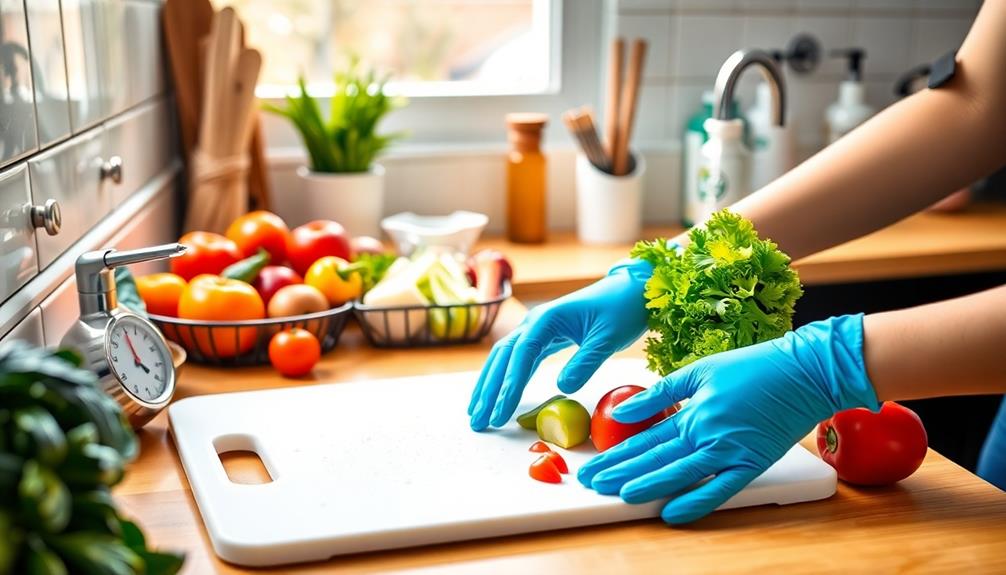
Food safety hinges on four essential steps: Clean, separate, cook, and chill. By following these principles, you can greatly reduce the risk of foodborne illnesses in your home kitchen.
- Clean: Always wash your hands with soap and water for at least 20 seconds before and during food preparation. This helps prevent the spread of harmful bacteria.
- Separate: Keep raw meats, poultry, and seafood away from other foods. Use different cutting boards to avoid cross-contamination.
- Cook: Confirm that all food reaches safe internal temperatures. This kills harmful bacteria that could cause illness.
- Chill: Store perishables in the refrigerator at 40°F or below, and freeze items at 0°F or below. Keeping food out of the danger zone (40°F to 140°F) is crucial, as bacteria can multiply rapidly if food is left at room temperature for more than two hours.
Safe Handling Techniques
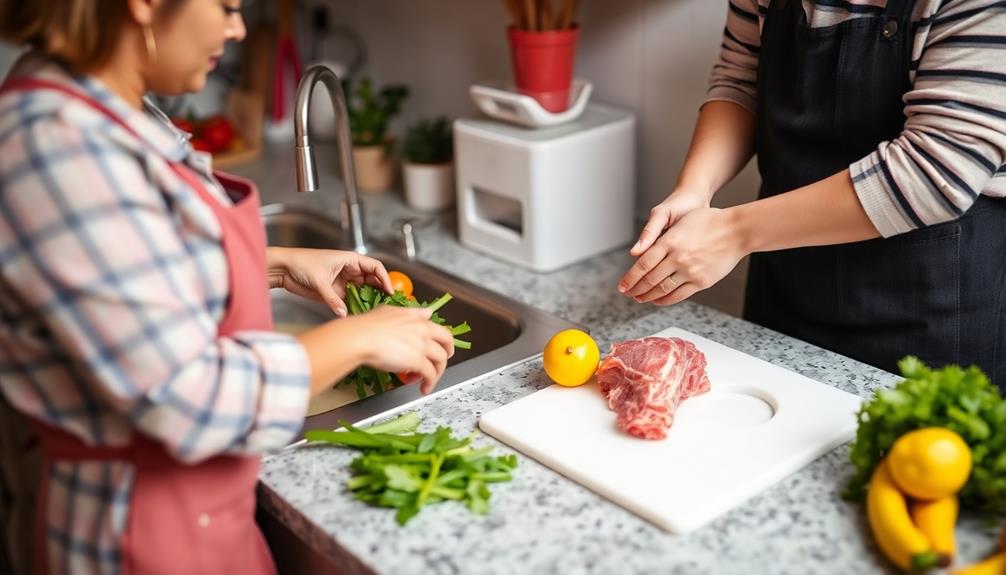
When it comes to safe handling techniques, washing your hands with soap and warm water for at least 20 seconds is a must before you touch any food. This simple step helps minimize the risk of cross-contamination from germs and bacteria.
Always use separate cutting boards and utensils for raw meat and produce to prevent pathogens from transferring to ready-to-eat items.
When thawing food, avoid leaving it at room temperature; instead, use the refrigerator, cold water, or microwave. Thawing at room temperature can promote bacterial growth.
For fruits and vegetables, rinse and scrub them under running water to remove dirt and reduce pathogen risks. Remember, raw meats should never be washed, as this can spread bacteria.
If you're going to marinate food, always do it in the refrigerator. Marinating outside can accelerate bacterial growth and increase the risk of foodborne illness.
Best Practices for Food Serving

Serving food safely is essential to prevent foodborne illnesses. You need to adopt best practices when serving food, especially if you're dealing with raw meat or perishable items. Here are some guidelines to keep in mind:
- Always keep perishable foods refrigerated until serving, making sure they stay below 40°F to prevent bacterial growth.
- Limit the time that cooked dishes are left at room temperature to no more than two hours.
- Use clean serving utensils for each dish to avoid cross-contamination, and sanitize shared items between uses.
- Label and date leftovers before refrigerating, consuming them within 3 to 4 days for ideal food safety.
Additionally, encourage your guests to wash their hands before eating. Proper hand hygiene is important in preventing the spread of foodborne pathogens.
By following these practices, you can greatly reduce the risk of foodborne illness and make certain that everyone enjoys a safe dining experience.
Resources for Ongoing Education
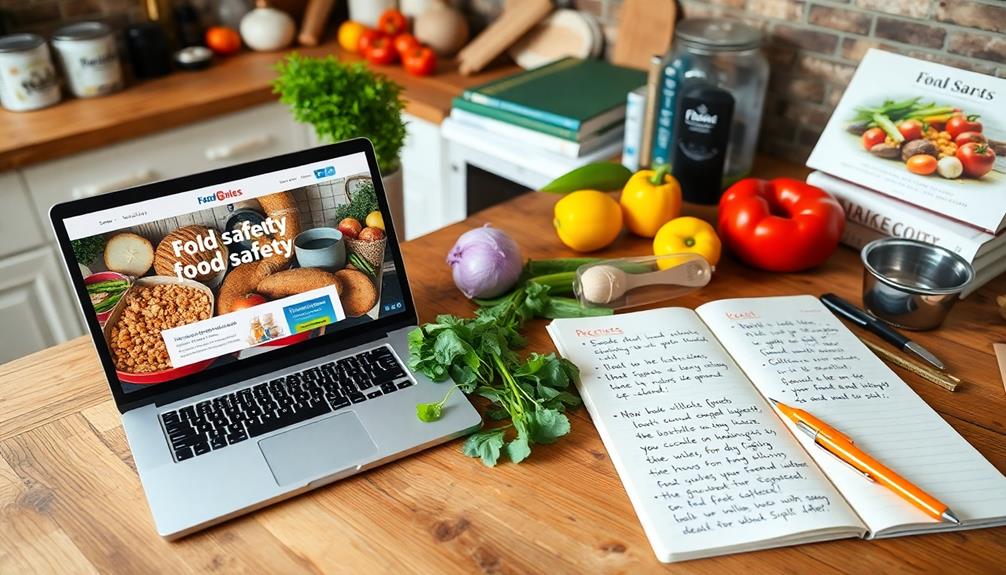
Continuing your education on raw food safety is essential for maintaining best practices in the kitchen. You can access a variety of resources to stay updated on food safety, especially regarding raw meat and food preparation techniques. Here are some key resources you should consider:
| Resource | Description |
|---|---|
| AskKaren.com | Automated food safety info tailored for home cooks. |
| USDA Meat and Poultry Hotline | Direct assistance on safe handling practices. |
| Government Websites | Stay informed on product recalls and safety alerts. |
| Community Cooking Classes | Enhance skills in raw food safety and techniques. |
| Online Forums & Social Media | Share experiences and get support from fellow cooks. |
Empowering Home Cooks
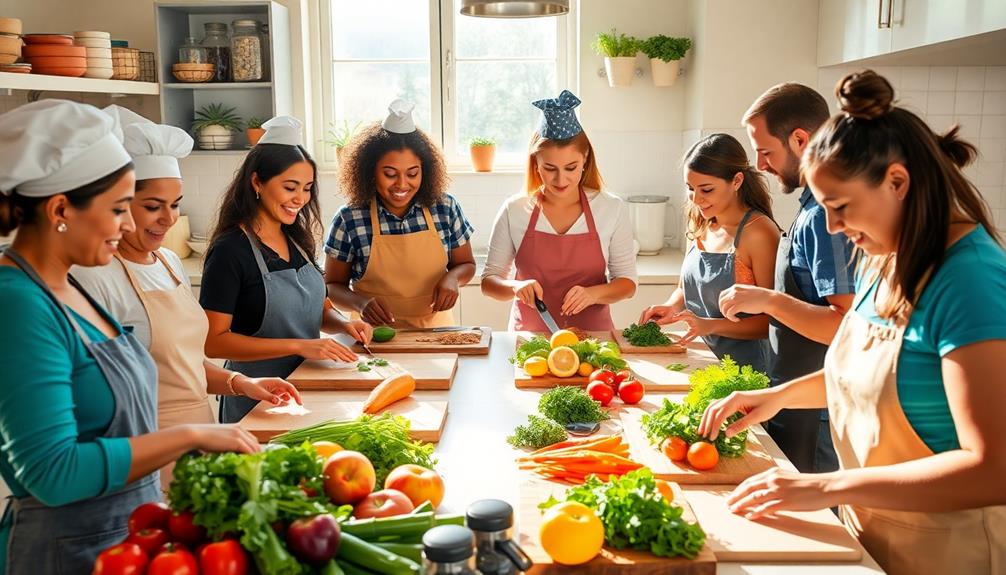
Empowering home cooks is essential for creating a safe kitchen environment. When you're well-informed about food safety practices, you can greatly reduce the risk of foodborne illness in your home.
Here are some key practices to keep in mind:
- Wash your hands for at least 20 seconds before and during cooking to eliminate harmful bacteria.
- Avoid cross-contamination by using separate cutting boards and utensils for raw meat and fresh produce.
- Store food safely by keeping your refrigerator at 40°F or below, steering clear of the danger zone.
- Cook food to safe temperatures, like ensuring poultry reaches at least 165°F, to destroy pathogens.
Frequently Asked Questions
What Are Your Food Safety Practices at Home?
You should wash your hands often, use separate cutting boards for meats and veggies, and refrigerate perishables promptly. Always clean fruits and veggies under running water, avoiding cross-contamination to keep your food safe and healthy.
What Are the Four Basic Food Safety Rules?
Imagine a castle: Clean the walls, Separate the rooms, Cook the feasts to perfection, and Chill the wine. These four rules—Clean, Separate, Cook, and Chill—guard your health against foodborne dangers lurking in the shadows.
What Are the Rules for Food Safety in the Kitchen?
In the kitchen, you should wash your hands regularly, use separate utensils for raw and cooked foods, cook meats to safe temperatures, refrigerate perishables promptly, and wash fruits and veggies thoroughly before use.
What Are the Core 4 Food Safety Tips?
When it comes to food safety, you've gotta keep your ducks in a row. Focus on the Core Four: Clean, Separate, Cook, and Chill. These practices help you prevent foodborne illnesses effectively. Stay safe!
Conclusion
By now, you've learned that mastering food safety is as essential as knowing your favorite recipe by heart. Remember, a little diligence goes a long way in preventing foodborne illnesses. Keep your kitchen clean, store your food safely, and always wash your hands—like a modern-day knight defending against the dragons of germs and bacteria. Empower yourself with knowledge and practice these habits, and you'll serve up delicious meals with confidence and care.

